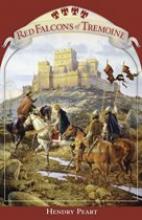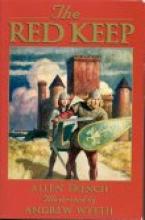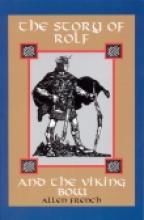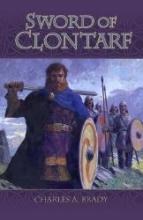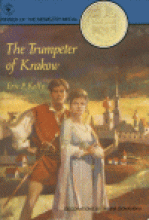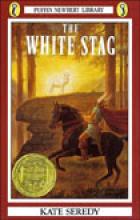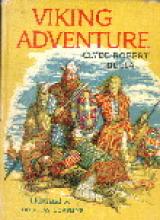Middle Ages
The Red Falcons of Tremoine
Suitable for ages 10 and up.
The Red Keep
Fifteen year old Conan is training for the knighthood and witnesses the Sauval firsthand as they plunder a neighboring castle. He rescues the only survivor of the family, their daughter Anne. She is taken in by the family that Conan is staying with.
By the time he is 20, Conan's father and brother have been killed by the Sauval. Anne tries to convince him that the Sauval will continue to strike his family, thus improving their position in the area, but Conan doesn't believe her until another brother is killed. Finally, determined to return the Red Keep to its rightful owner, Conan vows to avenge his losses and to stop the Sauval brothers from taking permanent control of the countryside.
His journey takes him to Vezeley to gather information from the Lord Abbot who secretly supports the Sauval. Here, Conan sacrifices his dignity by cutting his long hair, a sign of his rank in society, and learning the ways of the masons. He works alongside the masons as they do repair work for the abbot and is able to eavesdrop on the abbot and his men. The abbot then asks Conan and the masons to rebuild the Red Keep for the Sauval brothers. Conan convinces the masons to do the work, not for the abbot, but so that Anne can claim the Red Keep for herself. The plans and resulting battle make for a fast-paced, suspense-filled story.
The Red Keep is great reading for boys and girls. It's full of plenty of action and there is a subtle romantic storyline wound through. Allen French has created a believable main character that shows human weakness, yet is cunning and thoughtful at the same time. He has Conan realistically growing from a proud, rash youth into a loyal, kind man. All this occurs in 12th century France, which gives the reader a detailed picture of medieval life and the feudal system.
I agree with Bethlehem Book's recommendation of a reading age of 10 and up since the book contains some fairly violent scenes.
Reviewer age 13
The Second Mrs. Gianconda
The Second Mrs. Giaconda is a fascinating book about a young thief who becomes apprenticed to Leonardo da Vinci. This work of historical fiction is set in the latter half of the fifteenth century. The plot revolves around three characters- the famous artist, Leonardo, his apprentice, Salai, and the Duchess Beatrice d'Este. The novel is written from Salai's viewpoint, and we get a good feel for Leonardo's character. We see that Leonardo is shy, and yet brilliant. We see how Leonardo is so unreliable, particularly when he is distracted by his work. Leonardo was commissioned to paint a mural on the refectory wall of a local monastary in Milan. Unfortunately, he took so long with his masterpiece, that the monks began complaining about the loss of their dining hall! Leonardo is fascinated by everything around him. He studies plants, rivers, mountains, rocks and trees. He builds war engines, and studies flying machines. It is interesting to see the rivalry between Michelangelo and Leonardo, and how their lives intersect. The title, The Second Mrs. Gianconda, is a reference to the Mona Lisa, Leonardo's most famous work. The author uses this novel to weave the story behind the painting of the Mona Lisa. The back pages of the novel have black and white reproductions of some of the paintings of Leonardo da Vinci.
We used The Second Mrs. Gianconda as a read-aloud for our entire family. The novel was part of our Renaissance studies. This book was a good beginning to the study of the Renaissance artists. The book was entertaining, and informative. We would recommend it highly as a read-aloud, or for children ages ten and above.
Two references are disturbing in this book. One, the duke of Milan is involved, in two instances, with another woman. No mention of a sexual relationship is made, but it is still a problematic area for Catholic readers. And, secondly, on page 121, there is a reference to Isabella 'breeding dwarfs' for servants at her court. Though some texts contend that Leonardo had a homosexual affair with Salai, this novel makes no mention of that, or of any homosexual tendencies in Leonardo.
The Story of Rolf and the Viking Bow
One night, while a storm rages, Hiarandi's wife convinces him to light a beacon fire to help a ship which is foundering off the coast. This is not the normal practice of the time as the coast dwellers have come to rely on the booty from wrecked ships. His actions set off a chain of events which eventually lead to his own demise. The owner of the ship is Hiarandi's brother, Kiartan. Instead of thanking Hiarandi, Kiartan steals from him and leaves him to answer for a crime that Kiartan commits.
At the "Althing" meeting, Hiarandi's covetous neighbor, Einar, charges Hiarandi with the blood debt for Kiartan's crime. Einar wins a lesser judgement against Hiarandi, however, and Hiarandi is sentenced to remain on his own property for one year, that is, not to step off it more than one bow's-shot distance. Just before the year is over, Einar's men convince Hiarandi's only remaining thrall to run away. Hiarandi chases him to within one bow's shot distance but Einar's men are waiting and kill Hiarandi. Rolf, who witnesses the whole incident, kills one of the attackers and wounds several others. Einar claims that Hiarandi stepped out of bow shot distance from his property and so his death was legal. Although his own bow shot falls some feet short of the distance, Rolf insists that someone could be found to shoot the distance and prove his father's innocence. So he travels to seek someone who can shoot better than he. Along the way he wins the loyalty of many influential men and warriors who take up his cause, but none can shoot far enough.
Finally Rolf is outlawed for the death of Einar's man and he and his cousin flee Iceland. Einar gains Hiarandi's property and lives in the house which should have been Rolf's. While at sea, Rolf's ship is captured by Vikings and he and his cousin are taken captive. The Vikings are then defeated and captured by Orkney men. Rolf and his cousin are unlawfully made thralls of the Icelandic foster son of a thane of Orkney. This boy, Grani, lacks all the virtue Rolf possesses yet Rolf is able to teach him many things. They survive a Viking attack together and travel to warn the Earl of Orkney of the Viking invaders, becoming friends along the way. In all this adventure, Rolf acquires the bow from the burial mound of a Viking warrior.
Grani frees Rolf from his thralldom but as they return to Iceland, Grani reveals that his birth father is Einar. In his pride Grani will not ask Rolf forgiveness for all the wrongs he has done him since his capture so they must go to shore as enemies. Their ship crashes off the coast and Rolf rescues Grani bringing him to Einar's house. After escaping capture, Rolf disguises himself as a woman and lives a few months at his mother's dwelling up the hill from Einar and Grani.
At a harvest feast at Einar's house, in a marvelous scene, Rolf arrives disguised as the woman and shoots the Viking bow the distance to where his father fell, thus proving his death unlawful. Einar must forfeit the property and live up the hill at the dwelling where Rolf's mother had been. Rolf sends Einar and Grani trouble after trouble until Grani's pride finally breaks and he begs Rolf's forgiveness. Rolf immediately forgives him and they are restored as neighbors and friends and the unlucky curse on the Soursop line is ended.
Although this adventure is the story of Rolf's steadfast victory over his evil circumstances, it is also the story of the maturation of Grani. He begins as a self-indulged, selfish and wrongfully proud boy and he grows into an honorable man. All along the way he can see that Rolf is in the right, but he cannot bring himself to admit it to Rolf. Finally his will accepts what his heart knew all along. The last chapter of the book is drawn masterfully to this conclusion and is as satisfying as the scene where Rolf's bow shot vindicates his father.
There is much more to the story than this summary can cover. It is full of details of Icelandic and Orkney life and of the legal system to which the people are bound. The fact that it is written entirely, flawlessly as a Norse saga lends it authenticity and makes it a joy to read.
Recommended for grades seven and up
The Sword of Clontarf
The Trumpeter of Krakow
The story focuses on two Polish legends: the story of a young trumpeter in the church of Our Lady Mary, who keeps his oath as trumpeter, even to the death. The second is the Great Tarnov Crystal- reputed to be a thing of great beauty and power. Joseph Charnetski and his family are bound by an ancient oath to protect this famous jewel from any who would try to take it.
The Trumpeter of Krakow was first published in 1928. The book has several villians and many twists and turns in the plot. It is fast-paced and exciting. My brothers and I give it a nine out of ten rating. We all enjoyed the style of writing and found the plot adventurous. I would recomend this for grade six and up or a a great family read aloud.
The White Stag
The two sons do in fact lead the people west following a mysterious white stag which seems to be leading them along. They find a good land and stay there many years but it is not the land that was foretold. While in this land, Hunor and Magyar capture and marry fairy "moonmaidens." Hunor and his wife have a son named Bendeguz, The White Eagle. Among the people a slight rift appears and some become more attached to fierce Hunor and his son and others to the more gentle Magyar. The entire tribe moves on, however, and as they leave Asia and move into Europe, they become more fierce. The are in constant battle with the people of the lands they pass and end up a plundering, warring tribe. Finally they find a place to build a stronghold between the Volga and Don Rivers. Here Bendeguz marries a woman from the peoples they have conquered and Attila is born. The tribe then splits and Bendeguz, with Attila and his followers, move further west while Magyar and his followers stay. The Huns fight on and on with Attila as their leader and become the most feared people in the west. The story ends with the fulfillment of the prophecy, the finding of the promised land, and Attila leading a festival in thanksgiving to the great god Hadur.
This story could not be considered a history of the Huns, but might be read as a supplement to a study of the times. It is as the Greek myths are to the history of the Greeks and sheds light on the religion and traditions of the ancient Huns. It is poetically and lovingly written and full of beautiful illustrations. Since it is somewhat short in length, ( 95 pages of which 39 are full page illustrations), it can be read fairly quickly.
Recommended for grade 4+
Newbery Medal Winner
The Writing on the Hearth
England in the mid 1400's, Catholic perspective. Because this book does deal with the subject of witchcraft, I think it's probably appropriate for upper grade school and high school. It would be helpful to be familiar with the life of Saint Joan of Arc first. The story is of a teenage boy named Stephen who dreams of attending Oxford some day. He gets mixed up in a mystery/adventure which threatens to destroy that dream. The story nicely, but subtly shows his intellectual development as he matures. He discovers the importance of study in learning to discern the truth. One of the characters gives an excellent description of Classical Education and explains the Trivium and Quadrivium. The story provides lots of good discussion material, especially since the author seems to purposely provide some obscurity with regard to judging the character of some people.
Viking Adventure
The adventure soon takes an ominous turn as the ship encounters storms and the fears and dreams of the ship's owner, Halfred, who wants to turn back. The quarrel reaches a pitch between Gorm and Halfred, with murderous results that change Sigurd's life forever.
This book is one of many historical adventures written by Clyde Robert Bulla, and it is fast-paced and exciting like his others. Because of this, it might be a good book for an older reluctant reader. There is an interesting sub-plot about the value of the written word - at the beginning Sigurd refuses to learn to read and write because he doesn't see the point in his warrior culture, but in the end he changes his views when he has a valuable story to tell.
The terse style and fast pace is reminiscent of Norse sagas, and the lesson - that it takes hard work to become strong and skilled, and that even a warrior culture needs readers and writers - is a good one for a young person struggling to become literate. The reading level is probably about 2nd or early 3rd grade. I recommend this book for children ages 6 and up - a younger child could probably understand it, but might be upset by the fact that several main characters die during the course of the story.

